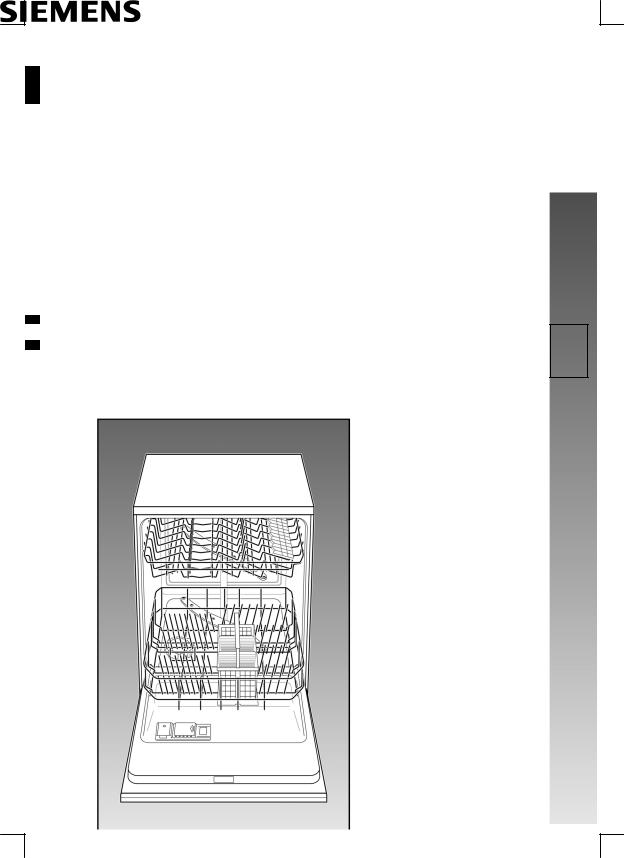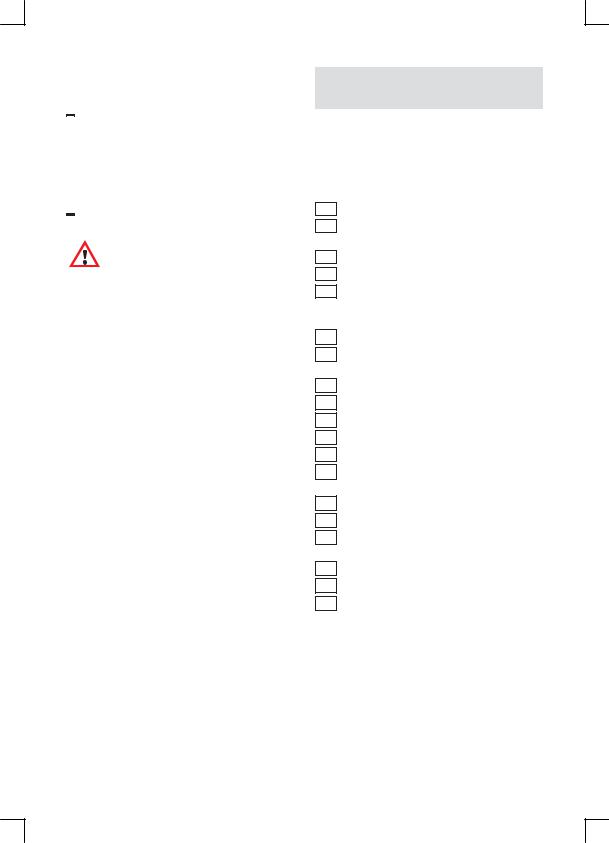Siemens Dishwasher all models Instructions for Use

Instructions for Use
en
5600 050 388 (8206)

en |
Index |
|
Safety instructions . . . . . . . . . |
3 |
|
Getting to know your dishwasher |
4 |
|
Water softener . . . . . . . . . . . . |
5 |
|
Filling the salt dispenser . . . . |
6 |
|
Filling the rinse-aid container |
7 |
|
Unsuitable dishes . . . . . . . . . |
8 |
|
Arranging crockery, glasses, |
|
|
etc. in the dishwasher . . . . . . |
9 |
|
Detergents . . . . . . . . . . . . . . . |
10 |
Programme overview . . . . . . |
13 |
Washing the dishes . . . . . . . . |
14 |
Maintenance and care . . . . . . |
16 |
Fault finding . . . . . . . . . . . . . . |
17 |
Customer Service . . . . . . . . . |
20 |
Information . . . . . . . . . . . . . . . |
20 |
Installation . . . . . . . . . . . . . . . . |
21 |

Safety instructions
Delivery
Immediately check the packaging and dishwasher for any damage which may have been caused in transit. Do not use a damaged appliance, but consult your supplier.
Please dispose of packaging material properly.
The corrugated cardboard consists mainly of waste paper.
The polystyrene moulded parts have been foamed without any CFCs. The polyethylene film (PE) consists partly of secondary raw material.
The wooden frames (if fitted) are made of residual wood and are untreated. The hoops (if fitted) consist of polypropylene (PP).
Installation
Install and connect the appliance according to the installation and assembly instructions.
The dishwasher must NOT be connected to the power supply during installation.
Ensure that the protective conductor system of the domestic electricity supply has been installed correctly. Electrical connection conditions must correspond with the specifications on the rating plate of the dishwasher. Built-under and built-in appliances should always be installed under a continuous work surface which is attached to the adjacent cupboards, in order to ensure that the appliance is entirely stable.
After the appliance has been installed, the mains plug should still be easily accessible.
en
During normal use
Warning
Knives and other utensils with sharp points must be loaded in the basket with their points down or in a horizontal position.
Use the dishwasher solely in a domestic environment and for its designated purpose: washing household tableware and other utensils. Do not place any heavy objects or stand on the door when it is open. The appliance could tip forward.
The water inside the dishwasher is not suitable for drinking.
Do not use solvents of any kind inside your dishwasher. They could cause an explosion.
Open the door very carefully if the dishwasher is operating. There is a risk of water squirting out.
If your family includes children
Do not permit small children to play with or operate the dishwasher.
Keep children away from detergents and rinse-aids.
Keep small children away from the open door of the dishwasher. There could still be some detergent left inside.
If a fault occurs
Repairs or other work on the dishwasher should only be carried out by a qualified specialist.
The dishwasher must be disconnected from the electricity supply before any repairs or other work are started. Pull the mains plug out of the wall socket or switch off at the fuse box. Grasp the plug to remove it from the socket; do not tug on the cable. Turn the water off at the tap.
3

en
When disposing of old appliances
Appliances that have reached the end of their service life should be rendered inoperable in order to exclude the possibility of subsequent accidents. Pull the mains plug out of the wall socket, cut through the connecting cable and disable the door lock.
Take the appliance to a designated waste disposal centre.
Warning
Children could get locked in the appliance (risk of suffocation) or get stuck in other positions.
Therefore: Remove the mains plug, cut the mains wire and set aside. Damage the door lock so that the door can no longer be closed.
Before using for the first time
The appliance was checked before it left the works. In order to remove possible water test remains, use the appliance for the first time without any dishes, using the highest temperature. Also fill salt, rinse aid and detergent in the filling compartments.
Getting to know your
dishwasher
Illustrations of the control panel and the interior of the dishwasher are shown on the rear fold-out cover of this manual. Fold this page out before you read the manual.
Control panel
1Programme selector
2Start positions for the individual programmes
3Door opener
4Main switch (ON/OFF)
5Programme overview
Appliance interior
20Top basket
21Additional cutlery basket for the top basket *
22Top spray arm
23Additional cup rack *
24Bottom spray arm
25Float **
26Bottom basket
27Dispenser for salt with refill indicator and water hardness range switch
28Filters
29Cutlery basket
30Dispenser for rinse-aid with refill indicator
31Detergent dispenser
32Catch
33Rating plate
*some models
4

** The float ensures that the appliance interior is not overfilled. Only customer service may maintain, remove and install the float.
You will need to purchase the following before using the dishwasher for the first time:
–special salt for use in dishwashers
–detergent
–rinse-aid
Only use products, which are suitable for dishwashers.
en
Water softener
In order to rinse dishes and glasses satisfactorily, the dishwasher requires soft water, i.e. containing little or no lime, otherwise water stains will be left behind on crockery and glasses, etc.
If the tap water exceeds a certain level of hardness, it must be softened, i.e. decalcified, so that it can be used in the dishwasher.
This is achieved by adding a special salt to the water softener inside the dishwasher.
The water softener, that is the required amount of salt, is set up according to how hard the tap water is.
Setting up the water softener
(see introduction)
5

en
Filling the salt dispenser
Function of the salt
The salt removes the hardness-causing constituents from the tap water.
Undo the screw cap on the dispenser 27 .
Before switching on the appliance for the first time, pour approx. 1 litre / 13/4 pt of water into the salt dispenser. Add salt until the salt dispenser is full (max. 1.5 kg / 3.3 lb). The water or salt solution is displaced by the salt and overflows.
The salt dispenser should always be refilled immediately before washing. This ensures that the overflowing salt solution is immediately washed out and does not remain on the floor of the appliance interior.
Then remove salt residue from the filling area and screw down the dispenser without jamming the screw cap.
Note
If the switch is set to ”0”, it is not necessary to add any salt, as none is consumed while the dishwasher is operating. If the switch is set between ”1” and ”3”, then salt must be added.
Do not pour detergent into the container for special salt. This would destroy the water softener.
LOW SALT indicator
Salt should be added as soon as the coloured dot in the lid on the salt container 27 is no longer visible.
6

Filling the rinse-aid
container
The purpose of a rinse-aid is to prevent the formation of water marks on tableware and utensils, and to ensure that glasses are clean and sparkling. The rinse-aid is consumed during the washing process.
Fold back the lid on the rinse-aid container 30 .
To open the lid, press the mark on the rinse-aid lid and simultaneously lift
the lid off the lug |
. |
Pour the rinse-aid into the filler hole until the level indicator turns dark. Close the lid, ensuring that you hear it snap closed.
Note |
Use only rinse aid for domestic dishwashers. Spilt rinse aid may result in excessive foam formation in the next rinse cycle. Therefore, remove any spilt rinse aid with a cloth.
en
Adjusting the amount of rinse-aid
The amount of rinse-aid added to the water can be varied by adjusting the stepless control. The rinse-aid control has been set to ”4” in the factory.
Do not alter the setting of the rinse-aid control unless streaks (turn knob towards ”–”) or water marks (turn knob towards ”+”) are left on the dishes.
30
rinse–aid control
LOW RINSE-AID indicator
As long as the LOW RINSE-AID indicator on the dispenser 30 is dark, there is sufficient rinse-aid in the dishwasher.
LOW RINSE-AID indicator
7

en
Unsuitable dishes
You should not clean the following items in your dishwasher:
Cutlery and dishes made of wood. They will leach out and become unsightly; the utilised adhesives are also not suitable for the dishwasher temperatures.
Delicate décor glasses, craft dishes and vases, special antique or irreplaceable dishes. These décor items are not dishwasher-safe.
Plastic parts, copper and tin dishes sensitive to hot water are not suitable either. Overglazed patterns, aluminium and silver parts tend to become discoloured and fade during the rinsing cycle. Even some types of glass (e.g. crystal glass objects) may become cloudy after many rinse cycles. Completely absorbent materials, such as sponges and cloths must not be cleaned in the dishwasher either.
Recommendation:
In future buy only dishes which are identified as dishwasher-safe.
Note
Dishes which are soiled with ash, wax, lubricating grease or ink must not be cleaned in the dishwasher.
Damage to glassware and other dishes
Possible causes:
type of glass or manufacturing process chemical composition of detergent water temperature and duration of dishwasher programme.
Suggested remedy:
Use glassware or porcelain dishes that have been marked ’dishwasher–proof’ by the manufacturer.
Use a mild detergent that is described as ’kind to dishes’. If necessary, seek further information from detergent manufacturers.
Select a programme with as low a temperature and as short a duration as possible.
To prevent damage, take glass and cutlery out of the dishwasher as soon as possible after the programme has ended.
8
